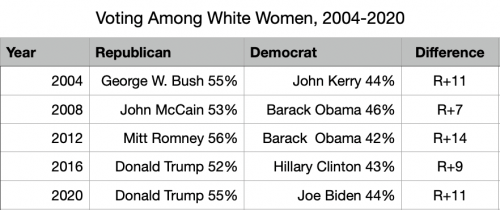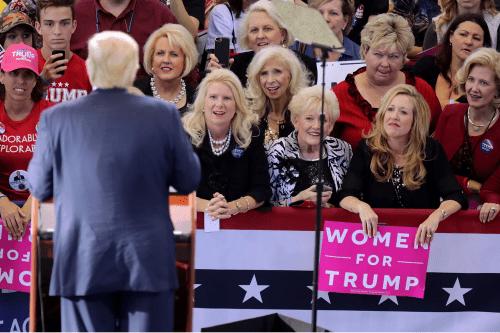After the 2016 election, I wrote a post on the status of white women in Trump’s coalition. Trump landed a surprise win over Hillary Clinton, and many people singled out white women as the key driver. In that previous post, I looked at the evidence and concluded that this is false. White women were not the key driver of Trump’s win.
White women have been moving toward the GOP for decades. They even moved slightly away from the GOP in 2016. And so, white women were not the decisive factor in Trump’s victory. It was white men who led Trump to victory. Insofar as, e.g., racial justice movements, singled out white women, it was likely because white women made a more attractive target than white men for moral appeals. Not because white women were key to Trump’s base.
With that as our starting point, let’s return to the issue of white women and Trump. How did 2020 go? Did white women vote for Trump again? Did movement in the votes of white women propel Biden to victory?
2020 Data on White Women and Trump
Let’s take a look at the data (via exit polls). First, here’s how white women voted from 2004 to 2020.

From the column on the right, you can see white women leaned Republican in each of the last five presidential elections. They always do. For a closer look, let’s see how white women compare to the national popular vote.

Here we find something more interesting. The column on the right shows how much more Republican white women lean than the national average. White women became increasingly Republican from 2004 to 2012. Hillary Clinton, by contrast, cut into that margin. She overperformed with white women. Biden, on the other hand, regressed back to previous trends. He did worse than Clinton, performing somewhere between Obama in 2008 and Obama in 2012.
Why Did White Women Move Toward Trump This Time?
How did Biden regress? Why did white women move away from the GOP in 2016 and then back toward the GOP in 2020?
The answer to these questions depends on why white women moved toward Hillary Clinton in the first place. In my previous post, I offered three possibilities: (a) white women identified with Hillary Clinton as the first woman President and this identification cut across ideological and partisan divisions; (b) Hillary Clinton heavily targeted (college-educated) white women as a part of her campaign; and/or (c) (college-educated) white women wanted to distance themselves from racist and misogynistic Trump supporters.
To make a modest claim, Trump supporters haven’t become less racist and misogynistic in the last four years. So, we can pretty safely rule out (c). (B) also seems unlikely. Biden also targeted white women. If anything, Democrats moved even more toward targeting white women since 2016, particularly college-educated, suburban white woman. And since Biden’s campaign was overall more successful than Clinton’s, it seems unlikely he’d have floundered with this group.
That leaves us with (a). Many white women – especially older, college-educated white women – saw a bit of themselves in Hillary Clinton. They wanted to see the U.S. elect her as the first woman president, and they voted for her to make it happen. Once another old white dude replaced Clinton on the ballot, they reverted to previous voting patterns.
Electoral Implications
What does all this mean? The next time Democrats try to elect the first woman president, they might land a surge of votes among white women. At least as long as their candidate is white. If they nominate, say, Kamala Harris, I have no idea whether they’ll win those votes.
But this shift in votes won’t last beyond a single election. Without the opportunity to elect the first woman president, white women still look like a Republican-leaning group. Possibly even a heavily Republican-leaning group. Their votes for Clinton didn’t seem to be tied to any particular partisan or ideological commitment. If the GOP nominates, say, Nikki Haley or Kim Reynolds in 2024, Haley or Reynolds might win those same votes.
